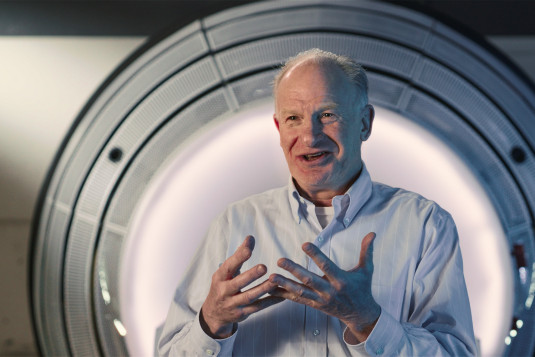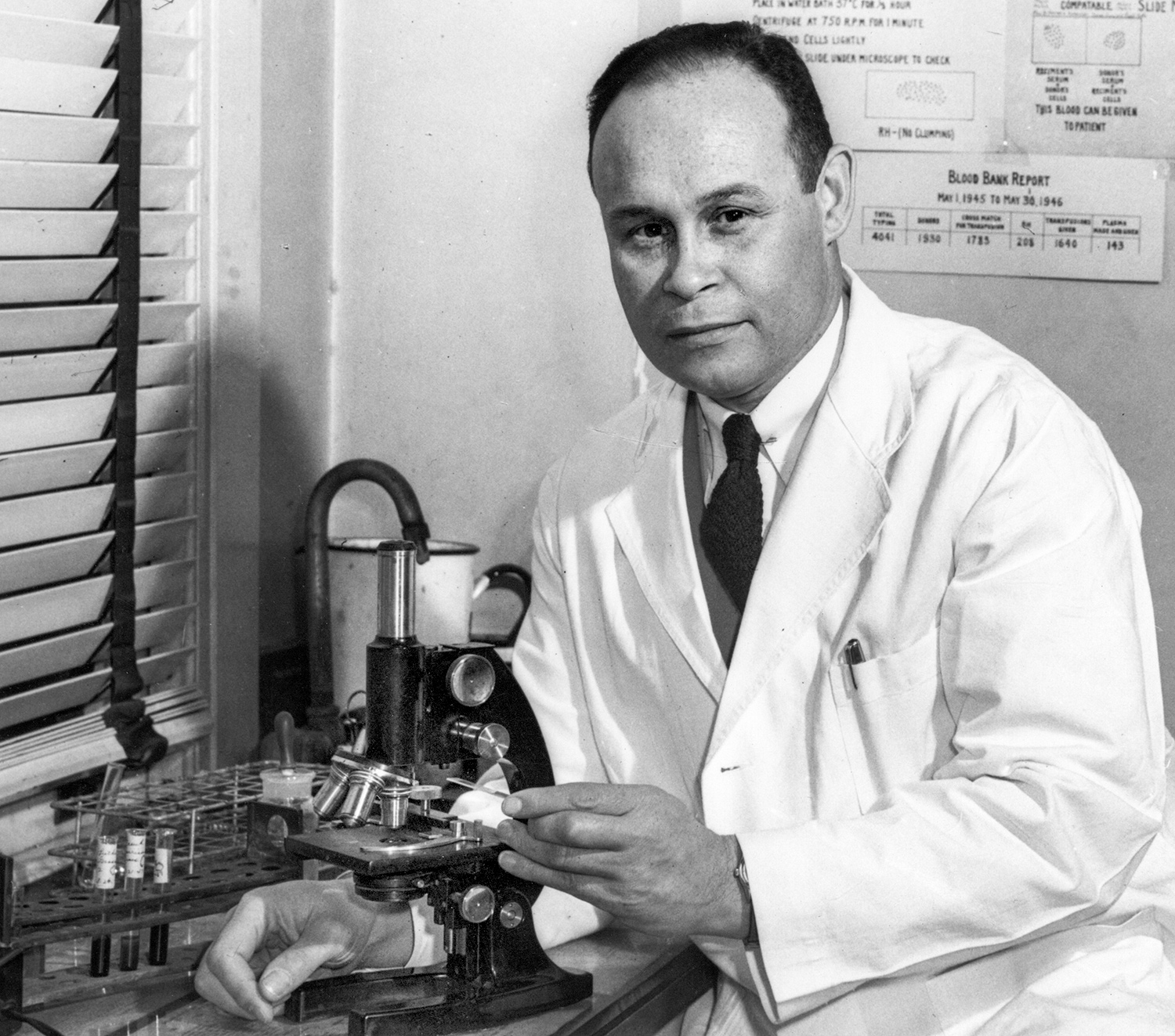
Planting a tradition of excellence
Surgeon and researcher Dr. Charles R. Drew saw his pioneering work in blood preservation and storage as just the beginning—a springboard to his true innovation: challenging racism by training a generation of Black surgeons. He was a passionate educator and determined advocate, fighting for more opportunities for Black physicians.
26 min read
Each month, our Journeys of Innovation series tells the stories of inventors or entrepreneurs who have made a positive difference in the world. This month, Leah Taber’s story highlights Dr. Charles Drew, a researcher, surgeon, and educator who pioneered blood preservation and storage while also advocating for more opportunities for Black physicians.
Do you know an innovator or entrepreneur with an interesting story?
Carrying a tray of bright red geraniums, Dr. Charles Richard Drew led his daughter to the backyard of their comfortable three-story house on the campus of Howard University in Washington D.C., where a circular arrangement of colorful blooms awaited them.
Working between 12 and 16 hours a day as a surgeon and scientist, Drew regularly abstained from vacations and church attendance, but always made time to tend the sizeable flower garden. On this warm spring day, he tasked his daughter, Sylvia, to help plant them.
Drew outlined her seemingly simple job in detail: dig a hole, take the flower out of its tray, place it in the hole, then pack dirt firmly around the plant so that the stalk would stand up straight and tall. The 5-year-old affirmed that she understood.
Knees in the dirt, Sylvia grabbed the garden trowel and repeatedly plunged the tool into the earth until she had made an adequate hole. Grasping the leafy green stem, she plucked the first flower out of the tray, placed it in the hole, and covered the base with dirt before looking to her father for approval.
Laying the small garden shovel down, Drew informed his daughter that they couldn’t move on to the next one. She protested: she had put the plant in the hole and covered the roots with dirt, just like he asked. He reiterated his stance and explained that, without packed dirt, the geranium could die because it didn’t have the support it needed to grow. They had to go back and try again.
“So I worked very hard to get that dirt packed hard around the flower,” Sylvia Drew Ivie – now 80 years old – recalled of that childhood memory from 1949. Drew praised her redone efforts, and they moved to the next plant. “And that’s the way we proceeded to plant all those little red flowers. I remember how important it was to me to listen to the instructions, to follow his directions, and to get it right.”

Photo on left: the Drew family: Drew and daughter Sylvia at left, daughters Bebe and Charlene center, and wife Lenore holding son Charles Jr. at right. Photo on right: Drew with daughters Bebe and Charlene. Daughter Sylvia recalled, "He was a uniquely loving person … his warmth and support of other people really transcended his contribution to science."
(Left photo courtesy of Charles R. Drew University of Medicine and Science. Right photo courtesy of Charlene Drew Jarvis)
Even in something as mundane as planting flowers, Drew firmly believed in adhering to a stringent standard of excellence. His children and medical students remembered his motto well: “Excellence of performance will transcend artificial barriers created by man.”
He maintained his commitment to excellence in whatever he did, from his research and groundbreaking leadership in blood plasma preservation and storage to what he saw as his most important innovation: training a cadre of elite Black surgeons at Howard University’s medical school and placing them in institutions and hospitals across the country. These efforts brought him into direct conflict with the prevalent racism that permeated every aspect of his life in Jim Crow-era America. But he had conviction that excellence would win the day.
Born June 3, 1904, in his maternal grandparents’ home in Washington, D.C., Drew grew up with four younger siblings in a house chock full of books in Foggy Bottom, named for the recurring early morning and evening fogs that rose from the nearby Potomac River to blanket the neighborhood. The Drews were part of the city’s thriving Black middle class, and “Charlie” lived in a supportive and loving household that expected the best of its members.
His mother, Nora, a graduate of Howard University, served on the Nineteenth Street Baptist Church’s Board of Trustees and started the first Black YMCA in Arlington, Virginia. His father, Richard, a red-haired, freckled family man, athlete, singer, and carpet-layer, was the financial secretary for the Local 85 of the Carpet, Linoleum, and Soft Tile-Layers Union — and its only Black member.
Drew emulated his parents by becoming a paperboy at 12 years old for the Washington Times and Herald and the Evening Star. By age 13, he had six other boys working for him at his newspaper enterprise.
His vibrant personality and unbending work ethic were the cornerstones of his character, Drew’s siblings recalled.
“[Charlie] played the saxophone badly, the piano loudly … and sang — we called them ‘Charlie’s shouts,’” his sister Nora said. A tall, powerful man, red-headed and freckled like his father, “He commanded respect by his presence.”
According to his youngest sister Eva, “Charlie was the reliable one … he worked hard and was very conscientious. He was totally organized down to the last t … I adored him and I was a little bit afraid of him.”
Drew’s ambition is captured in his 1922 senior year high school yearbook: “You can do anything you think you can.”
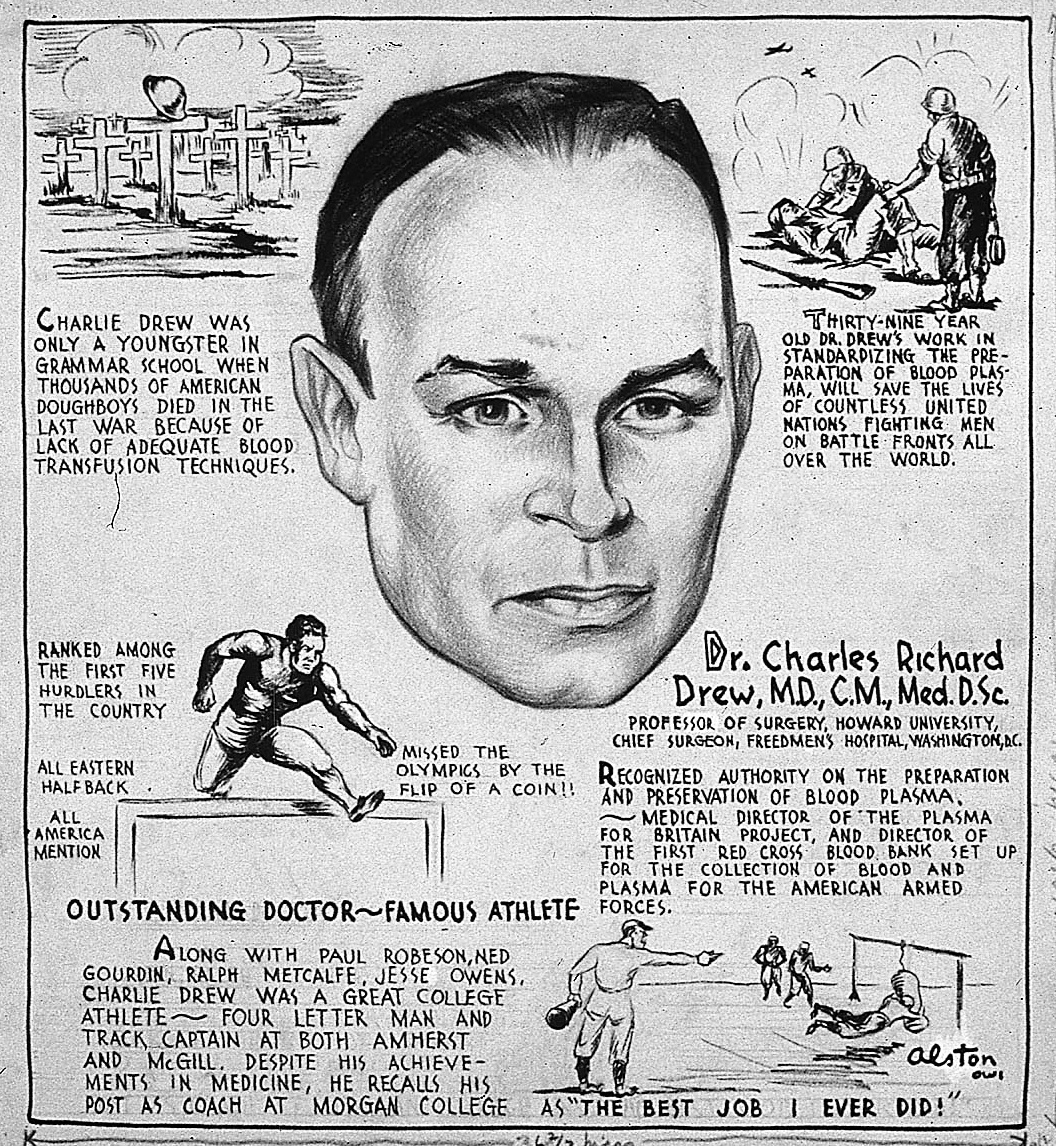
Black artist Charles Alston drew a series of posters celebrating the accomplishments of African Americans that were used during World War II to promote the war effort, including this one about Dr. Charles Drew. He was an exceptional athlete, surgeon, and researcher whose innovations played a vital role in helping wounded soldiers.
(Poster courtesy of the National Archives and Records Administration)
He excelled as an athlete, lettering in four sports at Dunbar High School, one of the best high schools for African Americans in the country and the best public college preparatory school in D.C., Black or white.
His achievements earned him an athletic scholarship to Amherst College in Massachusetts. It was here that he decided to pursue a career in medicine. It was also here, even as a standout halfback on the football team and a track and field star, that he couldn’t escape the pervasive racism of the day.
On a road trip with the Amherst track team for a meet against Brown University, Drew and three Black teammates racked up the majority of their team’s points, bringing victory to their school. Racism’s shroud soon marred the win — the owner of the Narragansett Hotel had learned that members of Amherst’s team were Black and refused to serve those athletes dinner. Drew and his Black teammates were asked to eat a spare meal in the Brown University commons, while the rest of the team ate at the hotel.
Drew’s excellence couldn’t overcome the stubborn policy of segregation at the Narragansett Hotel.
When he graduated from Amherst in 1926, Drew knew he wanted to go to medical school, but he didn’t have the money. He spent two years saving every penny working as an athletic director and as a biology and chemistry instructor at Morgan State College in Baltimore (now Morgan State University) before attending medical school at McGill University in Montreal, Canada.
Despite being a standout student and athlete at McGill, he again struggled to make financial ends meet. In a 1930 “Letter to the New Year,” he lamented, “I have a dollar — I am afraid to spend it — tomorrow I must eat and the day after … I never ask favors. This I know — that this pride sustains me when otherwise I would sink … My independence I must maintain … for as a man, I am the equal of any man I meet.”
He worked as a waiter and received a loan from former Amherst classmates, thanks to his former football coach. A much-needed scholarship came through in the nick of time his third year.
After he received his medical degree and completed his residency, Drew came home in 1935, accepting an appointment to Howard University’s medical school faculty. His father had died, and he now needed to be closer to his family.
Over the next 15 years, Drew would complete a surgical residency and a two-year fellowship, conduct world-changing research and work in blood preservation and storage in the middle of an earth-shattering world war, and reach the pinnacle of his career as a renowned surgeon and trainer of other Black surgeons.
Shortly after his arrival, Howard’s leadership recognized Drew’s potential and awarded him one of the first two-year fellowships for advanced training at Columbia University in New York City in 1938. He was assigned to work under Dr. John Scudder, a fortuitous match. Scudder’s research focused on fluid balance and blood storage and preservation, topics that first interested Drew at Amherst that he further studied at McGill. His 1940 dissertation, “Banked Blood,” put him at the top of the field and prepared him for the work that would bring him international acclaim. He was the first African American to earn the Doctor of Science in Medicine degree.
But he saw his surgical residency at New York City’s Presbyterian Hospital, which he completed alongside his research, as the crowning jewel. In the hospital’s wards, Drew honed the skills that he craved to take back to Howard and start his life’s work training Black surgeons. He made his desire known in a May 1940 letter to former Dunbar High School coach Edwin Henderson:
“[For] seventy years there has been a Howard Medical School but still there is no tradition; no able surgeon has ever been trained there; no school of thought has been born here; few of their stars have ever hit the headlines. In American surgery, there are no Negro representatives … all Negro doctors are just country practitioners … not given to too much intellectual activity and not particularly interested in advancing medicine. This attitude I should like to change. It should be great sport."
In the middle of outlining his career trajectory, Drew’s ambitious pursuit of excellence led him to his wife, Minnie “Lenore” Robbins, a young instructor of home economics at Spelman College in Atlanta, Georgia. He met her in the spring of 1939 when he stopped in Atlanta to visit friends on his way to a clinic at Tuskegee. He proposed three days after their first encounter, completely head-over-heels in love. He wrote to Lenore shortly after returning home, “Later, when I become coherent, I shall perhaps see many things, but tonight this one thing alone seems to ring clearly — I love you.” They were married in September, settling into a New York apartment while Drew continued at Columbia. They would eventually have four children together: “Bebe” Roberta, Charlene Rosella, Rhea Sylvia, and Charles Richard, Jr.
When Drew completed his degree at Columbia in June 1940, he thought he would return to Howard University and begin building his cadre of Black surgeons. But global catastrophe soon intervened.
The carnage of World War II brought an acute need for sterile, readily accessible blood plasma to treat wounded British soldiers fighting on French battlefields. Scientists had determined that plasma, the yellowish fluid part of blood that contains protein and holds red blood cells, could be separated from the red cells and used as an effective treatment for trauma or shock, when fluids needed to be rapidly replaced. It was cheap to produce; had a long shelf life in liquid, dried, or frozen form; posed little danger of causing adverse reactions; and had a lower risk of disease transmission than whole blood.
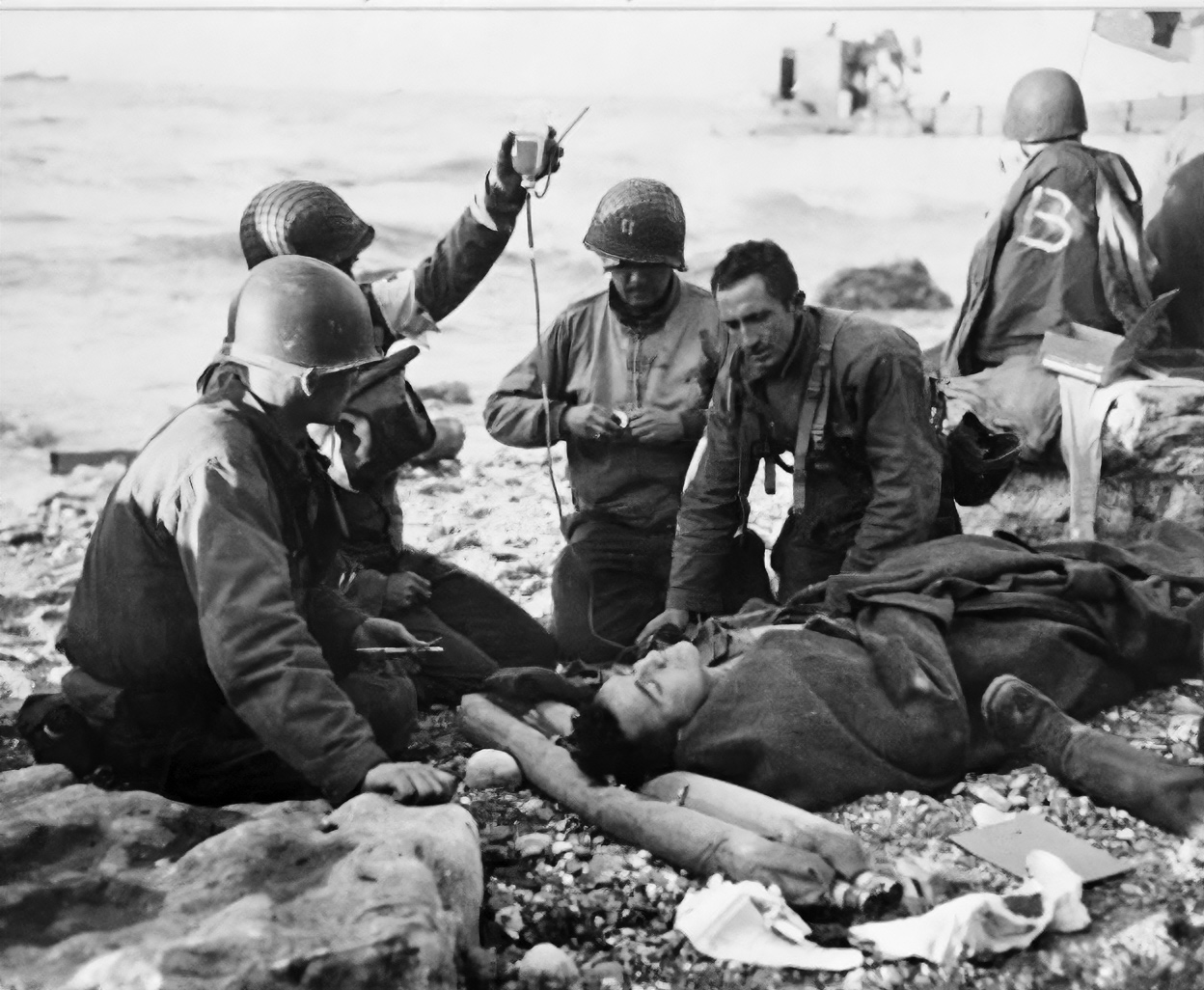
Drew’s lauded work saved thousands of Allied soldiers' lives—even as he continued to face racism and discrimination at home.
(Photo courtesy of the National Museum of Health and Medicine)
When the New York-based Blood Transfusion Betterment Association created the Blood for Britain program in June 1940 with the support of the American Red Cross, they needed someone to establish stringent standards and processes for blood plasma collection and production — someone with strong organizational skills who could map out the logistics of shipping a large amount of plasma to Europe, all while keeping the plasma sterile and stable.
Drew was the ideal choice.
He and Scudder had conducted blood banking clinical trials at Presbyterian Hospital, and he stayed at the forefront of the latest research about blood preservation. He also happened to be a perfectionist with very high standards, top-notch attention to detail, and a leader’s ability to unify those under him toward a common purpose. Drew took on the gargantuan task of synthesizing the best of previous research and organizing it into processes that made it possible to produce the large quantities of plasma needed in the midst of global conflict.
According to his daughter Sylvia, “He wasn’t a soldier in the war, but he was in the war.” He served as medical director of the Blood for Britain project from September 1940 to January 1941. By October 1940, Britain was receiving uniform, stable shipments of sterile blood plasma. His final report on the project brought national and international recognition of his expertise in blood collection, processing, and storage.
When Britain started developing its own plasma processing centers and no longer needed American assistance, the U.S. turned to developing its own national program. Again, Drew was a natural fit. From February to April 1941, he functioned as medical director of the pilot dried plasma program at New York City’s Red Cross blood bank. During that time, he put his creativity to work with an idea to use refrigerated trucks as mobile blood collecting units: bloodmobiles.
The timing and circumstances surrounding World War II had lined up perfectly for Drew to prove his mantra, “Excellence of performance will transcend artificial barriers created by man,” or, as he paraphrased in other moments, “Perform well, and segregation will disappear.” He had been chosen because he was a gifted scientist who worked hard and possessed the skills needed to do the job, and he had done the job well.
“He had done something that saved lives, and people knew it. He overcame societal prejudice [with] his science” and became a “kind of Joe Lewis of the medical field,” recalled Sylvia. In the present day, he’s lauded as the “Father of the Blood Bank.”
However, despite all of Drew’s achievements and accolades, racism soon stained his efforts. In late 1941, the Red Cross announced that it would follow the Armed Forces policy of refusing blood plasma donations from Black Americans — only white donors could contribute. After an immense storm of protest, the organization changed its policy from exclusion to segregation — blood plasma would be separated by race.
At first, Drew protested against the segregationist policy in letters to friends, colleagues, and military officials when he had the chance, explaining calmly and logically that the policy had no scientific basis. His method of fighting racism involved “doing and showing,” climbing to ever greater heights in the scientific arena.
“The human body to him was uniformly the same whatever you were, and blood was uniformly the same whatever you were,” Ivie added.
However, he recognized the need for stronger protest and Black leadership when it arose. When he received the National Association for the Advancement of Colored People’s (NAACP) 1943 Spingarn Medal for his work in blood plasma research, he made his first public speech attacking the blood segregation policy in the spring of 1944:
"It is unfortunate that such a worthwhile and scientific bit of work should have been hampered by such stupidity … I feel duty bound under such honors to become more aware of the great needs we have in all fields of activity when leadership is forced upon one in a manner quite comparable to this … I pledge you that in the future as I have tried in less degree in the past, I shall try to be worthy of this great honor … It is imperative therefore that we meet this new form [of discrimination] and smash it as we must smash all the others."
The Red Cross did not change its policy of segregating blood until December 1950 — after Drew’s sudden death.
When Drew left the Red Cross and returned to Howard in April 1941, he channeled his desire to overcome racism with excellence in surgery, his true passion and “chief interest,” as professor and chief of surgery at the university’s medical school and chief surgeon at its affiliated Freedmen’s Hospital. He would train a group of Black surgeons, motivating them with a powerful combination of genuine warmth and unwavering tenacity to show them how to break through racial barriers as he had done.
Just as he meticulously tended his backyard garden, ensuring the dirt was packed firmly around the geraniums he planted with his daughter, he would nurture his residents and give them the confidence they needed to pursue excellence. They would meet the most stringent standards for practicing medicine, then he would place them in institutions and hospitals across the country. Dr. Paul B. Cornely, who succeeded Drew as medical director at Freedmen’s Hospital, carried the metaphor further: “His boys” could then “act as seeds for the growth of other centers” of Black excellence.
His daughter Charlene affirmed, “He was determined that he was going to have surgeons who were the very best in the country.” This would be his greatest innovation.
He expressed his beliefs in a January 1947 letter to Mrs. J. F. Bates, a Fort Worth, Texas schoolteacher:
"There are many difficulties to overcome, it is true... When, however, one breaks out of this rather high-walled prison of the ‘Negro problem’ by virtue of some worthwhile contribution... part of the wall crumbles. And so it should be the aim of every student in science to knock down at least one or two bricks by virtue of his own accomplishments.”
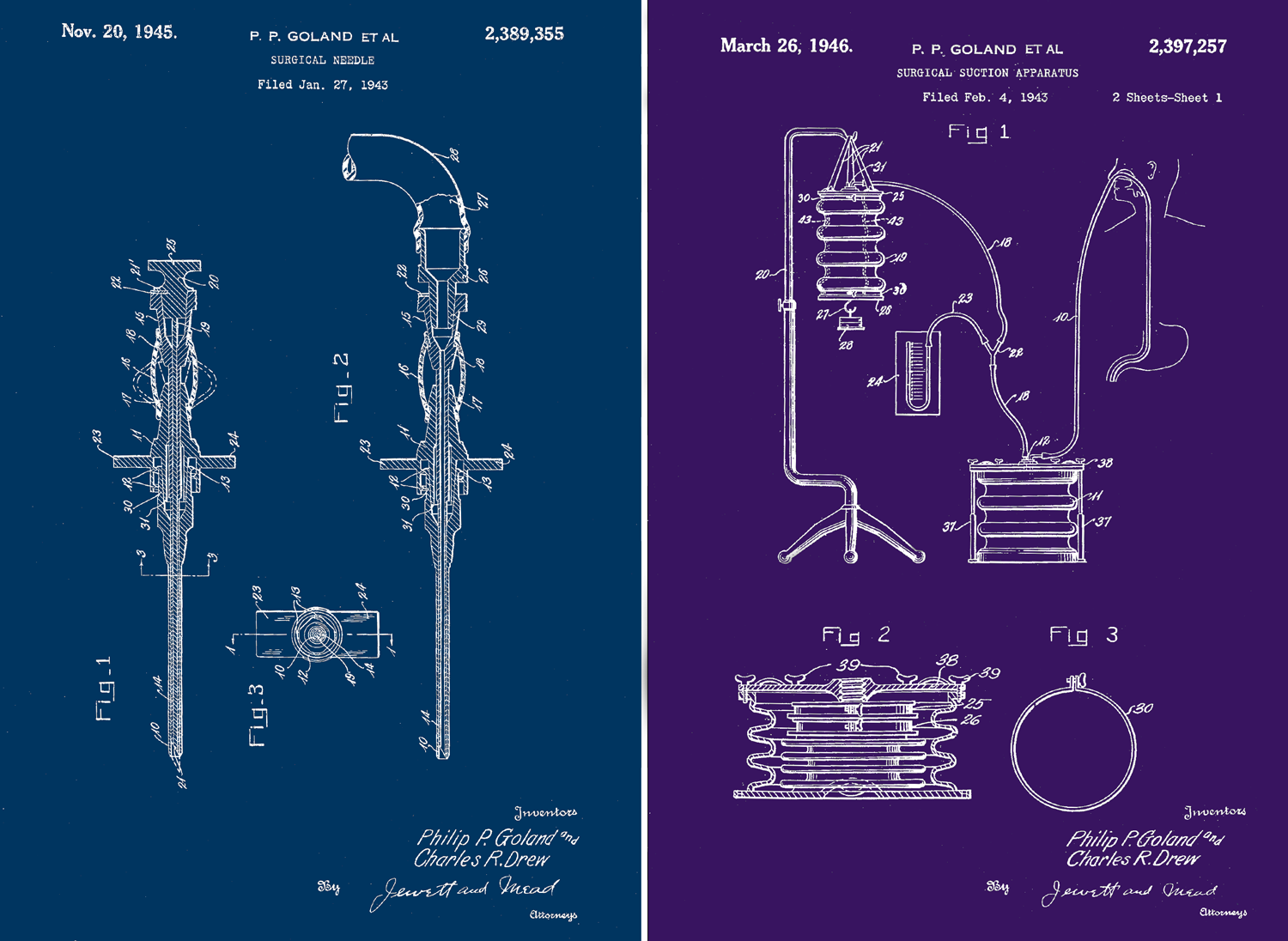
Drew wrote in a 1948 letter, "My chief interest was and is surgery." The two patents on which he's named as a co-inventor are for improvements to surgical tools.
Surgery was his first love, and it showed. He was certified by the American Board of Surgery in April 1941 and appointed as the first Black board examiner in October. He was later elected as a fellow to the International College of Surgeons and served as a consultant to the U.S. Surgeon General. The two patents on which he’s named as a co-inventor are for improvements to surgical tools: the design of the “Surgical needle” protected by U.S. Patent No. 2,389,355 made it easy to clean and prevented clogging, while the “Surgical suction apparatus” (U.S. Patent No. 2,397,257) was sturdy, compact, and cheaper to manufacture than other devices of the day – qualities that made it perfect for military or wilderness use.
Sharing the vision of medical school dean Numa P.G. Adams, Drew wanted to transform Howard University Medical School and Freedmen’s Hospital into top-tier institutions, capable of training the finest Black surgeons and scientists and offering quality health care to the city’s African American population.
A labor of love that would encompass the rest of his life, Drew threw himself headlong into teaching.
“There is very little time for research, but the boys whom we are now helping to train, I believe, in time will constitute my greatest contribution to medicine,” he wrote in a 1947 letter to Amherst College president Charles W. Cole.
While his work as an educator was demanding, Drew cherished his role as his family’s loving provider and protector. When his daughter Charlene stepped on a piece of glass and cut her foot as she played in their front yard, he ran to the rescue.
“My foot bled rather profusely. My mother put me in a little red wagon and wrapped my foot. I looked up to see my father coming,” she said, adding that Freedmen’s Hospital was just a block away from their house on College Street, and Lenore had called her husband to help. “His white coat ... and his tie [were] flapping in the wind, so he was coming very, very fast.”
Charlene worried that her father would be angry that she was outside without shoes, “but he was gentle. He rewrapped the foot and pulled me in that little red wagon over to Freedmen’s Hospital.”
Like his children, Drew’s students remembered "Big Red” as a passionate educator, advocate, and model who cared for them deeply, but held them to strict standards. He was warm and understanding, but hard-driving and firm. He insisted on excellence, but readily offered confident encouragement to students in whom he saw potential. Burke Syphax, one of Drew’s students who later taught surgery at Howard, remembered of Drew’s teaching style, “His forte — what made him different — was his knack of stimulating others. He went beyond being a teacher; he was a leader of men.”
His daughter Sylvia put it another way: “His insistence on excellence ...[was] not beating it out of people but loving it out of people.”
When his first batch of graduates traveled to Johns Hopkins University in 1948 to take their certification exam before the American Board of Surgery, Drew was overcome with intense concern as he waited to hear the results. His wife Lenore recalled, “... he had never been more anxious about anything... ‘Your boys will do alright,’ I tried to console him. ‘All right won’t be good enough,’ he said. ‘They’re up there at Hopkins competing with graduates of the top medical schools ... with rich boys, Lenore, boys who’ve had every advantage.’”
He went down into the basement, picked up a sledgehammer and pounded against an old coal bin stored in the space.
“He just used all his energy and anxiety about how his students were doing to just bang this old disposable bin into a piece of flat metal,” said his daughter Sylvia. “All we heard was bang, bang, bang upstairs. But that’s the way he worked it out.”
As it turned out, his worries were unfounded: two of his students came in first and second in the exam. After he found out the good news, he dropped into a chair.
Lenore remembered, “Tears filled his eyes ... and his voice dropped to a whisper. ‘First and second. Well, what do you know about that?’”
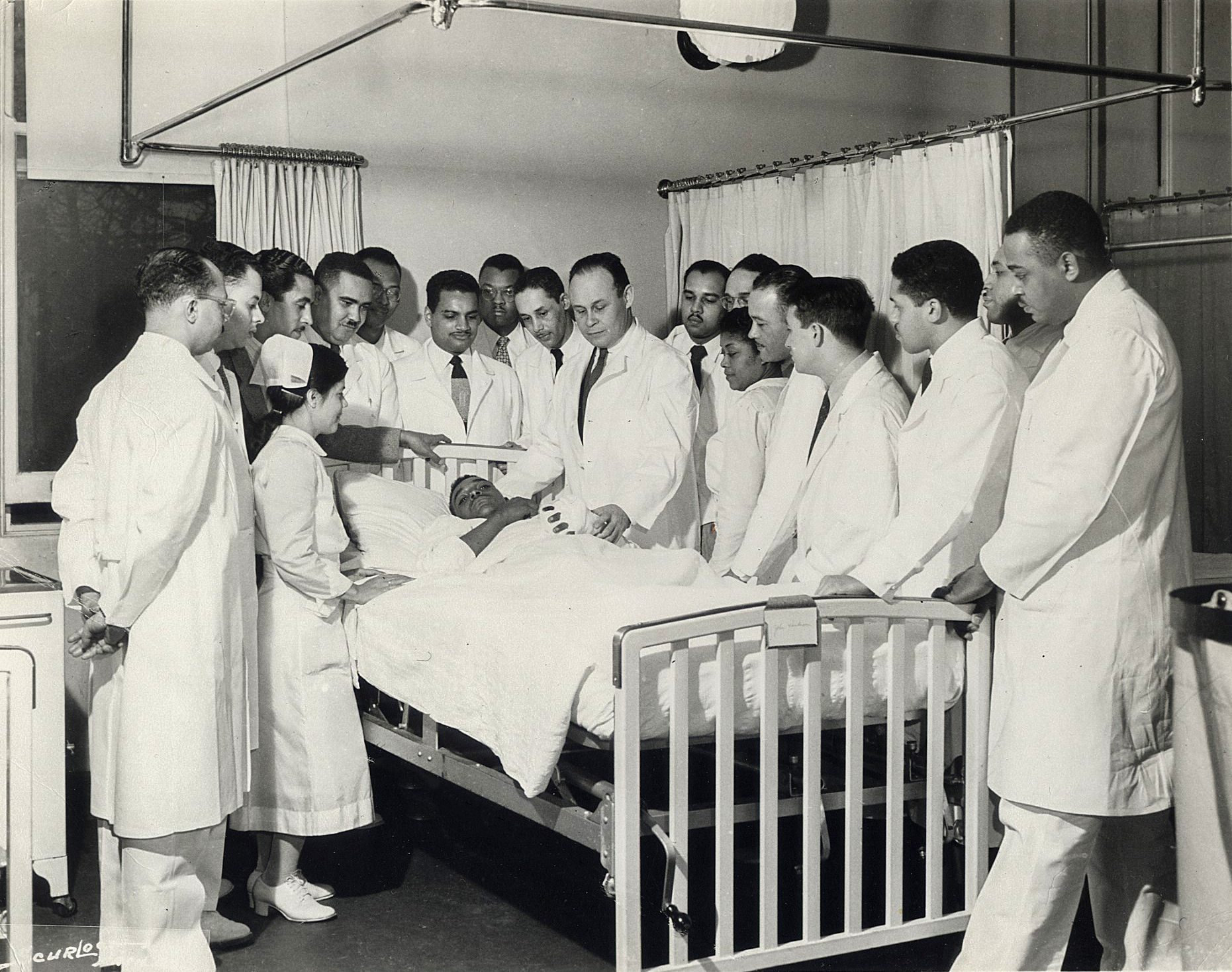
Drew teaching interns and residents during rounds at Freedmen's Hospital. When asked about Drew's educational impact for a 1978 article in Ebony Magazine, former student Dr. Charles D. Watts declared, "He helped prepare a whole generation of surgeons and a whole new thrust in training...Black surgical training has never been the same."
(Courtesy of Charlene Drew Jarvis)
Drew’s attention didn’t stop in Howard's halls — he was involved in the day-to-day lives of his residents and cared how they carried themselves. He sometimes paid travel expenses out of his own pocket for residents to be able to attend beneficial medical meetings.
He kept in touch with former students, encouraging them to continue their hard work and lauding the gradual creation of a community of Black medical excellence. In an October 1946 letter to former student Dr. Jack White, he wrote, “Our fellows are rapidly creating something which gives them a sense of ‘belonging to.’ Within the protection of this feeling, they should be able to accomplish more than the fellows who have gone before.”
Drew also pushed his best students to go further in their training, to specialize after they finished their residencies and climb as high as they could in the medical field. This meant fighting to secure internships and specialty training for them at white institutions, battling against racial prejudice once more. He challenged segregationist hospital policies and fought against racial restrictions in medical associations, insisting that Black doctors and surgeons gain access to these institutions to get the training, experience, and standing they needed and deserved.
In 1947, Drew’s ongoing campaign against racial barriers came to a head when he took on one of the most storied institutions in the nation’s medical world: the American Medical Association (AMA).
Even though he was internationally recognized for his blood banking work and as a gifted surgeon, he couldn’t become a member of the AMA because of the local District of Columbia chapter’s racial restrictions. Neither could his medical residents.
The national body left it to the local chapters to determine membership parameters, and the District of Columbia chapter prohibited qualified Black doctors from joining.
These racial policies not only hurt Black physicians' pride; they also hampered careers. Black doctors couldn’t admit their patients to local hospitals, which meant that they often had to refer patients to white doctors. This damaged their own community's confidence in their abilities. Furthermore, they couldn’t get the hospital experience they needed to continue their education, and research funding was hard to come by without proof that AMA standards had been met.
Enough was enough.
In January 1947, the centennial anniversary of the AMA’s founding, Drew wrote a scathing letter to the editor of the Journal of the American Medical Association. He recounted the rigorous standards at Howard and Freedmen’s Hospital, then lamented that, despite adherence to these high standards, Howard’s Black physicians were still excluded from the AMA community. He castigated “one hundred years of racial bigotry and fatuous pretense,” then closed with a clarion call to action: the AMA “should not start its second century with unfinished business of this kind making mockery of its continuous protestations of leadership in medicine under the great and free American way of life.”
When Journal editor Dr. Morris Fishbein answered by pointing to the AMA’s longstanding policy that membership came through admittance into local chapters, Drew responded indignantly, chastising Fishbein, “You know and I know that it is utterly impossible for a Negro physician to become a member of a county medical society in the South.”
He called on the AMA to change its bylaws and allow qualified doctors membership without having to go through county societies. He declared that Black doctors “should no longer have to explain on every application blank why they are not eligible for membership in the [AMA]. It is an unwarranted stigma. It is a cause of repeated humiliation.”
The AMA didn’t change its constitution and bylaws to prohibit racial discrimination until 1968. Drew died without ever becoming a member.
A tragic car accident early on the morning of April 1, 1950, cut short Drew’s Herculean efforts to overcome racial segregation and discrimination with Black excellence. After a full day of performing surgery, teaching, attending university events, and doing hospital rounds, he was traveling with three colleagues to the John A. Andrew Hospital annual free clinic in Tuskegee, Alabama, when he fell asleep at the wheel, overcorrected, and crashed near Burlington, North Carolina. His passengers escaped with minor injuries, but Drew was not so lucky. The segregated hospital to which he was taken used every possible measure to save him, but his injuries were too great. He died at 45 years old.
The news shocked Howard University’s population and the wider medical community. Then 6-year-old Sylvia remembers row upon row of white-coated residents and faculty sitting in the chapel, grieving their loss. Then-8-year-old daughter Charlene watched car after car drive by in the funeral procession, astounded at the number of people who cared for her father.
Bolstered by loyalty, love, and a sense of responsibility, his heartbroken students came to the Drew house one by one to ask if they could help Lenore learn to drive. She now needed this skill desperately: she was a widow who had to assume the role of single parent to four children.
They and others also collected money for a down payment on a new house through the newly created Charles R. Drew Memorial Foundation. With Drew’s passing, the family was required to move out of university housing.
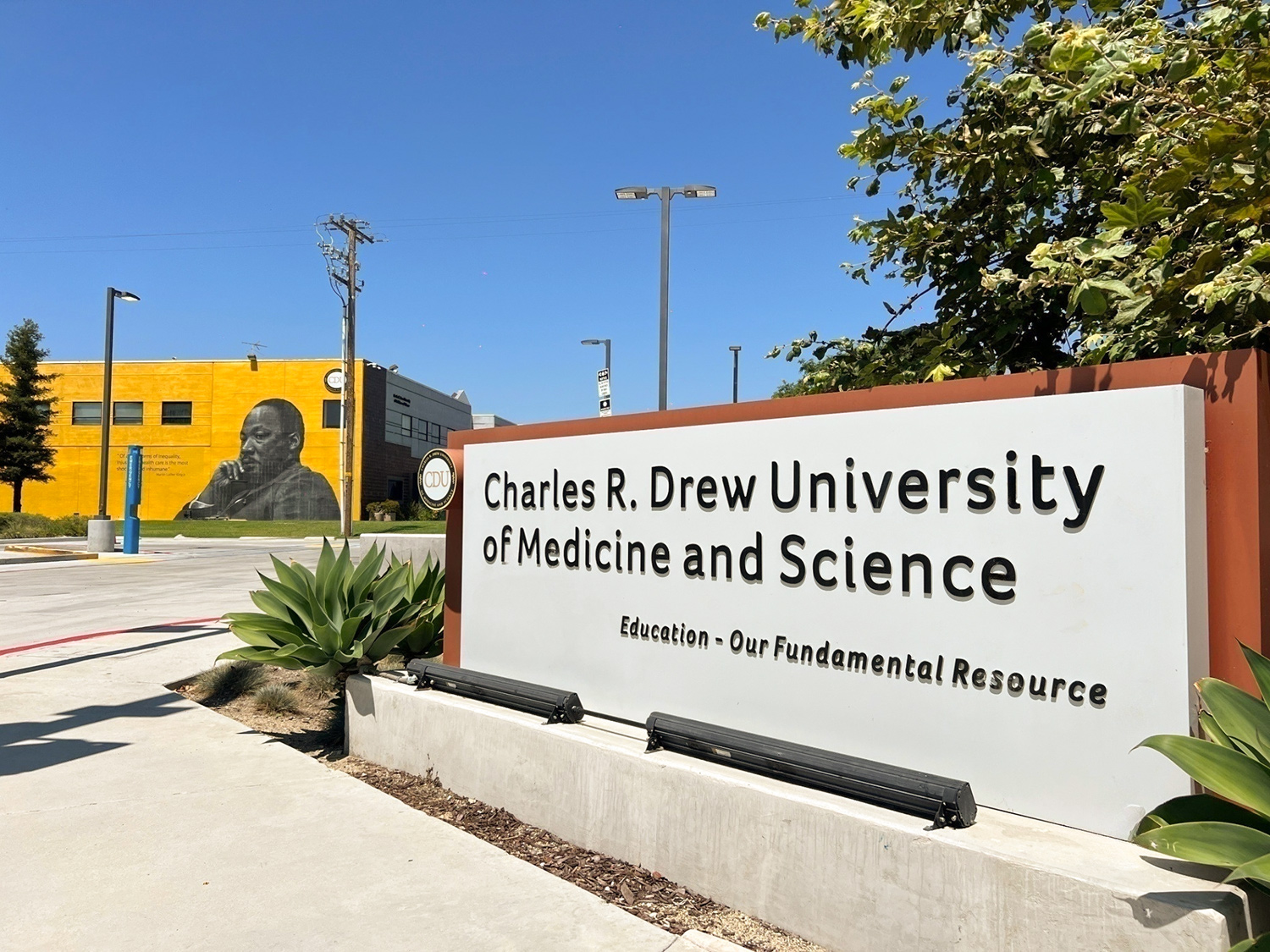
Charles R. Drew University of Medicine and Science is one of several educational institutions that bear Drew's name and continue his teaching legacy.
(Courtesy of Charles R. Drew University of Medicine and Science)
Drew left behind an incredible legacy at Howard’s department of surgery. He created, trained, and nurtured the first members of his hoped – for community of Black surgeons – the flowers he planted, steeped in excellence. From his appointment to his post in 1941 to his untimely death in 1950, he trained over half of the Black surgeons certified by the American Board of Surgery, and another 14 surgeons who received part of their training from him passed the boards after his death.
“I can’t tell you the number of physicians or students… who have used my dad as... a role model for their own lives,” said his daughter Charlene.
His belief in the importance of excellence also left an indelible mark on his children. Charlene Drew Jarvis, a former neuroscientist, District of Columbia City Councilwoman, and Southeastern University president, stated, “What we understood from him is that we could achieve, we should achieve, and we would achieve.” She described his sense of drive as “genetic... like a horse that never sleeps.” Celebrating the continued influence of her father’s “message about excellence of performance,” Charlene declared, “My son repeats that. My nieces and nephews repeat that.”
Sylvia Drew Ivie, former lawyer for the NAACP Legal Defense Fund and healthcare liaison for the Los Angeles County Board of Supervisors, and current special assistant to the president of Charles R. Drew University of Medicine and Science (CDU), believes her father passed on a sense of duty to care for others, and she used that impetus to pursue a career that combined healthcare access and civil rights.
Fittingly, given his belief in the power of rigorous education to overcome racial barriers, dozens of public schools all over the country are named for Drew. Located in D.C., Drew Elementary School was one of the first, dedicated just 10 years after his death on April 29, 1960.
Named for Drew and established in South Central Los Angeles in 1966 in the wake of the Watts Revolt, CDU emerged after years of local insistence that this underserved neighborhood of Black and brown citizens needed better access to quality healthcare.
Drew understood that need: in 1940, he declared that inadequate healthcare for African Americans was one of the biggest medical problems in the county.
“He understood the healthcare challenges and inequities,” said his daughter Charlene.
The school’s first president, Mitchell Spelman, was one of Drew’s former residents.
Today, CDU works to provide students who come from underrepresented populations with opportunities for medical education, training them in turn to work with underserved communities. Drew’s daughter Sylvia, who now works at CDU, celebrates the school’s connection to her father’s legacy:
“We have a whole school of people here, primarily people of color, who are studying at an institution which bears his name and whose life is proof that they can rise to whatever level their talents take them.”
The flowers Charles Richard Drew planted are still growing.
Credits
Produced by the USPTO’s Office of the Chief Communications Officer. For feedback or questions, please contact inventorstories@uspto.gov.
Story by Leah Taber. Contributions by Jon Abboud, Bill Lincicome, and Whitney Pandil-Eaton. Special thanks to Sylvia Drew Ivie, Charlene Drew Jarvis, Jonathan Zaleski and Marissa Wells, Charles R. Drew University of Medicine and Science, Sonja N. Woods, University Archivist, Moorland-Spingarn Research Center, Howard University, and Nicole Baker, Librarian, National Library of Medicine.
References
American Red Cross. “Dr. Charles R. Drew’s Life & Legacy: A Chat with his Daughter Dr. Sylvia Drew Ivie.” June 3, 2022. Sylvia Drew Ivie interviewed by Tiffany Taylor. https://redcrosschat.org/2022/06/03/dr-charles-r-drews-life-legacy-a-chat-with-his-daughter-dr-sylvia-drew-ivie/
American Red Cross of the National Capital and Greater Chesapeake Region. "Dr. Charles R. Drew - Through the Eyes of a Daughter." September 30, 2014. https://www.youtube.com/watch?v=O8O3Jrh5SIU
Bims, Hamilton. “Charles Drew's 'Other' Medical Revolution." Ebony, February 1974, 88-96.
CBS Mornings. "The Life and Legacy of Charles Drew, the African American Doctor Who Pioneered Blood Banks." May 23, 2020. https://www.youtube.com/watch?v=vFddM7p2zH4
Charles R. Drew University of Medicine and Science. “About Charles R. Drew University.” https://www.cdrewu.edu/about/
Cobb, W. Montague. "Charles Richard Drew, M.D., 1904-1950." Journal of the National Medical Association 42, no. 4 (July 1950): 238-246.
Cornely, Paul B. “Charles R. Drew (1904-1950): An Appreciation.” Phylon 11, no. 2 (1950), 176-177.
Cornwell, Edward E., III, David C. Chang, and La Salle D. Leffall, Jr. "Dr. Charles Drew, a Surgical Pioneer." Annals of Surgery 243, no. 5 (May 2006): 612-618.
Drew, Charles R. Letter to the Editor of the Journal of the American Medical Association. January 13, 1947. Charles R. Drew Papers. Howard University, Moorland-Spingarn Research Center, Washington, D.C.
---. Letter to Edwin B. Henderson. May 31, 1940. Charles R. Drew Papers. Howard University, Moorland-Spingarn Research Center, Washington, D.C.
---. Letter to Gladys C. Hardwick. June 26, 1944. Charles R. Drew Papers. Howard University, Moorland-Spingarn Research Center, Washington, D.C.
---. Letter to Jack White. October 31, 1946. Jack White personal papers. Washington, D.C.
---. Letter to Jessie F. Harris. September 17, 1948. Charles R. Drew Papers. Howard University, Moorland-Spingarn Research Center, Washington, D.C.
---. Letter to Mrs. J. F. Bates. January 27, 1947. Charles R. Drew Papers. Howard University, Moorland-Spingarn Research Center, Washington, D.C.
---. Letter to Lenore (Robbins) Drew. April 13, 1949. Charles R. Drew Papers. Howard University, Moorland-Spingarn Research Center, Washington, D.C.
---. Letter to Morris Fishbein. January 30, 1947. Charles R. Drew Papers. Howard University, Moorland-Spingarn Research Center, Washington, D.C.
---. Letter to the New Year. January 1, 1930. Charles R. Drew Papers. Howard University, Moorland-Spingarn Research Center, Washington, D.C.
---. “The Spingarn Medal.” NAACP Bulletin, September 1944, 11.
Drew, Lenore Robbins. “The Unforgettable Charlie Drew.” Reader’s Digest, March 1978, 1-6.
Fishbein, Morris. Letter to Charles R. Drew. January 22, 1947. Charles R. Drew Papers. Howard University, Moorland-Spingarn Research Center, Washington, D.C.
Ivie, Sylvia Drew. Interview by Leah Taber. December 5, 2023.
Ivie, Sylvia Drew. Interview by Leah Taber. December 15, 2023.
Jarvis, Charlene Drew. Interview by Leah Taber. January 12, 2024.
Love, Spencie. One Blood: The Death and Resurrection of Charles R. Drew. Chapel Hill, North Carolina: The University of North Carolina Press, 1996.
National Library of Medicine. “Profiles in Science: Charles R. Drew: The Charles R. Drew Papers.” https://profiles.nlm.nih.gov/spotlight/bg
NPR StoryCorps. “Remembering the Father of Blood Banking, a Black Doctor Who Took a Stand.” Updated August 25, 2021. Charlene Drew Jarvis and Ernest Jarvis interviewed by A. Martinez. https://www.npr.org/transcripts/1025372235
Parker-Kelley, Darlene. "Keeping Dr. Charles Richard Drew's legacy alive." Journal of the Medical Library Association 107, no. 3 (July 2019): 449-453.
PBS NewsHour. "The Daughter of the Black Doctor Who Invented Blood Banking Says, 'We Knew Him as a Father.' March 18, 2021. Charlene Drew Jarvis interviewed by Bria Lloyd. https://www.youtube.com/watch?v=uZGova5sW34&t=8s
The Washington Evening Star. “New School is Dedicated to Dr. Drew” (April 29, 1960).
Wynes, Charles E. Charles Richard Drew: The Man and the Myth. Chicago: University of Illinois Press, 1988.



